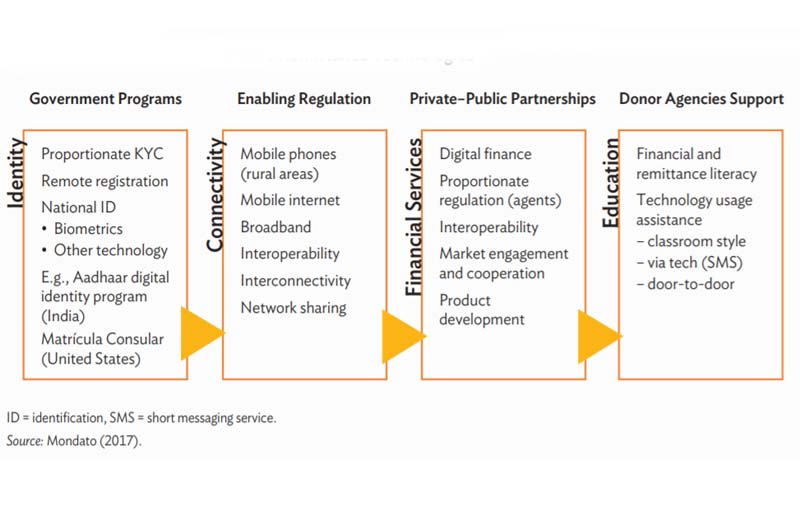
The Asian Development Bank (ADB) has released a report
looking at how finance and technology
can aid the positive impact of migration on home countries.
According to the
report, around 75% of global remittances projected in 2017 ($443 billion out of
$593 billion) came from developing countries, particularly in the East Asia and
Pacific and South Asia regions. The World Bank estimates that the number will
continue to grow by 3.5% to $459 billion by 2018.
The report notes
that the remittances have a significant development impact. They increase
household income which can be spent for social services such as education and
health. In addition, they can contribute to financial services expansion and
drive growth of inclusive finance.
But these benefits
are hampered by high costs which impact the efficient flow of remittances.
Though the costs are declining, they remain at 14%-20% for all developing
regions. The worldwide average cost of bank transfer is 11%, a slight decline
from its 2008 level of 14.6%. The average costs for IMTOs (international money
transfer operators) are lower at around 6%, with post offices’ being 7%.
Remittance costs in
Asia have gone down to 8%, but are still above the global average (7.4%) and
the targets set by the United Nations’ Sustainable Development Goals (3% by
2030). A 5% decline in remittance costs could generate $15 billion in savings.
Information and communication technologies could play a key role in this area.
The basic mechanism
of cross-border remittance transactions, built around correspondent banking
relationships, hasn’t changed much during the past few decades. Most recent
innovations focus on repackaging efficiencies within the international financial
infrastructure according to the report.
Dependence on
back-end clearing and settlement entities adds opacity to remittance cost
structures. The report also notes that fluctuating foreign exchange rates obscures
the costs further, as the disclosure or estimation of such rates varies across
remittance service providers (RSPs).
Potential impact of digital technologies
Currently, purely
digital cash-in solutions cater to high-income sending to middle- and
low-income country corridors. The solutions can lead to substantial savings as
demonstrated by the 1% flat fee of TransferWise [1], but the benefits are limited to people who can deposit by local
bank transfer, debit or credit card (in select currencies), or SWIFT
international transfer. Savings with other providers are often similarly confined
to that sub-segment.
Access to digitised channels,
has not yet fully translate to usage. Obstacles include to inadequate value
propositions for merchants, weak stakeholder economics for card networks,
insufficient aggregate customer demand, inconsistent infrastructure and
regulatory frameworks, ineffective distribution models, and reluctance to pay
full taxes on previously unreported revenues.
The authors of the
report expect physical currencies to remain as the fallback for situations
where electronic acceptance is not available, either because one party lacks
the proper means, or they find it uneconomical, inconvenient, or both.
Some Fintech players
are seeking to consolidate and/or replace parts of the legacy remittance value
chain, while others want to reconfigure it in a more fundamental fashion.
The report
classifies Fintech propositions based on scale and scope of impact.
Status Quo Plus: Traditional
IMTOs using the well-established infrastructure of intermediary banks and
bilateral agreements along with SWIFT and focusing on optimising cash-in,
cash-out. Digital services may bring efficiencies, but are reliant on existing
core financial infrastructure.
Improved
Fundamentals: Here, international IMTOs seek to leverage their massive scale to
bring fixed cost efficiencies. An alternative model is to use aggregation with hubs
managing the corridors; multinational “borderless accounts” with providers
doing net transfers across their international accounts.
New Paradigm: The
objective here is to move toward significanty lower, even zero-fee services. These
companies are also exploring new revenue sources, such as user insights and
targeted advertising. Some are trying to leverage cryptocurrencies for
disintermediation and open APIs to make for more democratic access.
According to the
report, the third cluster of innovative technologies and business models could
prove especially disruptive and may require a complete reworking of the
existing competitive environment.
Decentralised
cryptocurrencies and distributed ledger applications could potentially address
the backend opacity. Blockchain-based solutions can provide granular transaction
history. They will also provide visibility of cross-institutional data by
numerous parties in real time, along with cash-out opportunities through
strategic partnerships. The distributed nature of access, would hinder any
attempts to falsify records.
Cryptocurrencies
could theoretically render intermediary banking infrastructure unnecessary.
Digital assets might then be transferred between two parties without external
permissions, which is then moved over a cryptocurrency’s secure network to the
receiver. However, the perceived illiquidity and volatility of cryptocurrencies
remains a challenge.
Central bank digital
currencies (CBDCs)
could produce a peer-to-peer (P2P) transfer network whose value would be
anchored by its 1:1 exchangeability with the other liabilities of a central
bank, cash, and reserves. CBDCs could also help to universalise a technological
standard for electronic payments.
The report cites the
Monetary Authority of Singapore as a pioneer experimenting with a
state-controlled cryptocurrency. Its Project Ubin has placed the tokenised
form of the Singapore dollar on a distributed ledger, the first of its kind
in Asia.
Interbank
distributed ledger technology applications, more widely, could bypass
correspondent banking and promote direct settlement between financial
institutions. Ripple recently announced that over 100 financial institutions
are now active on its enterprise blockchain network RippleNet, wherein
in-network banks can initiate and settle wholesale payments through
cryptotokens. IBM, Mastercard, JPMorgan, SWIFT, the Gates Foundation, R3CEV,
and more are all competing to establish a distributed ledger platform for
cross-border international payments.
At the moment though
these initiatives represent only a tiny sliver of cross-border flows. A consensus
has to be reached by all stakeholders over the utility of either
cryptocurrencies or distributed ledgers for realizing the large-scale
structural impact of the technology.
Government’s role
The report notes four
ways in which governments can play an enabling role for digital transformation of
remittances and driving greater financial inclusion.
Firstly, governments
can develop national IDs, potentially including biometrics and other
technologies. Examples include the Aadhaar digital identity program in India or
the Mexican Matrícula Consular in the US.
Initiatives such as
universal coverage programs for rural mobile broadband can facilitate wider
access to digital remittance channels.
Appropriate
regulation of distribution channels would also be important. The report states
that agents should be regulated on a risk-proportionate basis, as heavy
licensing and compliance requirements can limit their footprint and exclude the
local merchants that have been typical of mobile money. Interoperability can
help establish critical.
National awareness
campaigns, financial and remittance literacy, and technology usage assistance
(e.g., classroom-style sessions, via SMS, or even door-to-door) can be organized
through public-private partnerships and with possible donor agency support.
[1] Transfer-wise avoids currency exchanges
by rerouting money domestically. A euro outbound remittance is used to fund a
euro in-bound remittance.
Read the report, Labor Migration in Asia, Increasing the
Development Impact of Migration through Finance and Technology’ here. The section on 'Leveraging Remittance Technologies for Financial Inclusion in Asia' is available here.
















